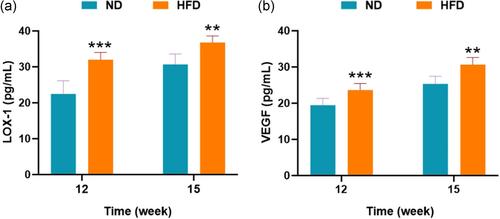Clinical studies have shown that atherosclerotic cardiovascular disease and cancer often co-exist in the same individual. The present study aimed to investigate the role of high-fat-diet (HFD)-induced obesity in the coexistence of the two diseases and the underlying mechanism in apolipoprotein E-knockout (ApoE−/−) mice.
Male ApoE−/− mice were fed with a HFD or a normal diet (ND) for 15 weeks. On the first day of Week 13, the mice were inoculated subcutaneously in the right axilla with Lewis lung cancer cells. At Weeks 12 and 15, serum lectin-like oxidized low-density lipoprotein receptor-1 (LOX-1) and vascular endothelial growth factor levels were measured by enzyme-linked immunosorbent assay, and blood monocytes and macrophages were measured by fluorescence-activated cell sorting. At Week 15, the volume and weight of the local subcutaneous lung cancer and metastatic lung cancer and the amount of aortic atherosclerosis were measured.
At Week 15, compared with mice in the ND group, those in the HFD group had a larger volume of local subcutaneous cancer (p = 0.0004), heavier tumors (p = 0.0235), more metastatic cancer in the lungs (p < 0.0001), a larger area of lung involved in metastatic cancer (p = 0.0031), and larger areas of atherosclerosis in the aorta (p < 0.0001). At Week 12, serum LOX-1, serum vascular endothelial growth factor, and proportions of blood monocytes and macrophages were significantly higher in the HFD group than those in the ND group (p = 0.0002, p = 0.0029, p = 0.0480, and p = 0.0106, respectively); this trend persisted until Week 15 (p = 0.0014, p = 0.0012, p = 0.0001, and p = 0.0204).
In this study, HFD-induced obesity could simultaneously promote progression of lung cancer and atherosclerosis in the same mouse. HFD-induced upregulation of LOX-1 may play an important role in the simultaneous progression of these two conditions via the inflammatory response and VEGF.


